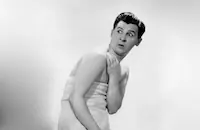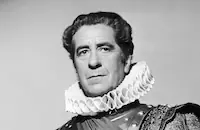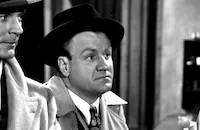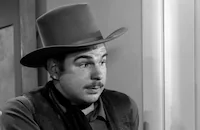The Fleet's In

Brief Synopsis
Cast & Crew
Victor Schertzinger
Dorothy Lamour
William Holden
Eddie Bracken
Betty Hutton
Leif Erickson
Film Details
Technical Specs

Synopsis
When star Diana Golden performs for a gathering of sailors, shy sailor Casey Kirby goes backstage to get her autograph for his sister. Casey is tricked into a publicity kiss with Golden for the cameras and when his buddy, Barney Waters, reports back to their buddies on ship, the kiss instantly creates Casey's reputation as a notorious ladies' man. When Jake, a real "Don Juan," bets Barney that Casey will not be able to kiss "The Countess," a dance hall singer who is renowned for her aloofness, Barney bets his friend Spike's antique watch, and wagers spread shipwide. Spike threatens Barney with death unless he wins the wager, and so when they dock in San Francisco, Barney immediately takes Casey to The Countess's dance hall, Swingland, and engineers Casey into sitting with the disinterested singer. The Countess pretends to take an interest in Casey when the manager tries to force an obnoxious patron on her, and Casey ends up walking her home. The Countess becomes charmed by Casey despite herself, and she invites him into the hillside apartment she shares with singer Bessie Dale. Bessie returns the same night with Barney, and both couples pursue their flirtations until Barney mentions his wager to Bessie. Bessie interrupts Casey and The Countess just as they are about to kiss and tells The Countess about the bet. Both Barney and Casey are thrown out of the apartment, but Casey soon realizes that he is sincerely in love with The Countess and buys an engagement ring. Bessie meanwhile reveals to The Countess a plan she heard from Barney, in which Casey will propose to her in order to get a kiss. When Casey does propose, the outraged Countess throws the ring out the window, but Casey explains his sincere intentions, and they retrieve the ring. That night during the show at Swingland, Casey tries to propose again while The Countess dances on a conga line. The club's bouncers think he is drunk and wrestle him to the floor, and a brawl ensues involving all the visiting sailors. Casey is dragged off unconscious as the shore patrol arrives and is later brought to trial as the initiator of the brawl. He refuses to defend himself until The Countess strolls into the courtroom and adopts a hard-boiled attitude, pretending that she deliberately led Casey on to get the ring, and that the bouncers threw the first punch. Casey is acquitted and in the taxi on the way to the Navy dock, Casey and The Countess are married by a minister. At the dock, all the sailors witness Barney win his bet as Casey and The Countess finally kiss.

Director

Victor Schertzinger
Cast

Dorothy Lamour

William Holden

Eddie Bracken

Betty Hutton

Leif Erickson
Betty Jane Rhodes

Barbara Britton
Cass Daley
Gil Lamb
Jack Norton
Roy Atwell

Robert Warwick
Lorraine And Rognan
Jimmy Dorsey
Bob Eberly
Helen O'connell
Hal K. Dawson
Gilbert Wilson
Harry Barris
Dave Willock
Rod Cameron
Jimmie Dundee
Jack Chapin
Donald Kerr
Tommy Sanford

Lyle Latell
Pat West
Fred Santley
Phyllis Ruth
Archie Twitchell
Chester Clute

Matt Willis
George Carleton
Jack Clifford
Stanley Andrews
Charles Williams
Edward Peil Sr.

James A. Millican
Reed Porter
Douglas Meins
George Turner
Katharine Booth
Alaine Brandes
Judith Gibson
Lynda Grey
Barbara Slater
Laurie Douglas
Blanche Grady
Louise Laplanche
Beth Hartman
Loretta Barnett
Forrest Dickson
Mary Jane Dolan
June Ealey
Brooke Evans
Ellen Johnson

Barbara Kent
Virginia Kepler
Connie Lamont
Elinor Troy
Alice Weaver
Crew
Monte Brice
Walter Deleon
B. G. Desylva
Jack Donohue
Hans Dreier
Ernst Fegté
Arthur Franklin
Earl Hayman
Edith Head
Paul Jones
William C. Mellor
Johnny Mercer
Ralph Murphy
Richard Olson
J. Walter Ruben
Victor Schertzinger
Sid Silvers
Ralph Spence
Hal Walker
Paul Weatherwax
Wally Westmore
Victor Young

Photo Collections
Videos
Movie Clip





Trailer
Film Details
Technical Specs

Articles
The Fleet's In
The Fleet's In is not, in fact, merely a remake of the 1928 film. It's based equally on a 1933 play entitled Sailor, Beware!, which itself had already been made into a 1936 film, Lady Be Careful, and would be adapted again in 1952 as the Jerry Lewis/Dean Martin vehicle Sailor Beware.
This 1942 version stands as a tuneful, silly-yet-wonderful piece of wartime escapism. It was shot in September and October 1941 and opened in theaters in March 1942, a different world for Americans. Now that the country was at war, a rousing and energetic film with sailor characters seemed made to order. Equally appealing was a fun cast including William Holden, Dorothy Lamour, Eddie Bracken and Betty Hutton as well as the Jimmy Dorsey big band and a bunch of swell new Johnny Mercer songs including the soon-to-be standard "Tangerine."
"I don't know why I called it 'Tangerine,'" Mercer said years later, "except that it had a kind of Latin flavor, the melody." That melody had been composed by Victor Schertzinger, who collaborated with Mercer on all the film's songs and also directed the movie itself. Mercer had never worked with Schertzinger before but enjoyed the collaboration. "He gave you a tune on a lead sheet, and whatever you brought in pleased him," Mercer recalled. "As they say, a doll to work with."
The Fleet's In did a lot for Mercer's career. His songs were so successful that they caused his ASCAP ranking to be raised from A to AA - meaning that Mercer would now receive royalties at the same level as top songwriters like Cole Porter and Irving Berlin.
Certainly another song that helped him achieve this is "Arthur Murray Taught Me Dancing in a Hurry," in which one verse goes: Arthur Murray then advised me not to worry/I'd come out all right/To my way of thinkin'/It came out stinkin'/I don't know my left foot from my right. (In a PR move when The Fleet's In came out, the real Arthur Murray offered Mercer and his wife free dance lessons.) The song was performed by 21-year-old Betty Hutton, making her feature film debut, and it helped make her a star. "That was a big hit song," Hutton later said. "Johnny Mercer, who's the greatest songwriter of all time, wrote the score. But I don't think that alone did it. The role was funny."
One critic of the time wrote of Hutton: "Her facial grimaces, body twists and man-pummeling gymnastics take wonderfully to the screen." But Hutton's physical wildness made it very difficult for her to hit her marks. As she later said: "I don't know from walking in and looking down and all that jazz. They said to me, 'This is a long shot. Take it easy on the medium shots a little more. Close up, really go.' I don't know from that jazz. Every time I came out I was 'on.' I wanted to be great."
Director Victor Schertzinger complained to producer Buddy DeSylva that he couldn't hold Hutton in the frame. "I didn't hire her to stay on the spot," DeSylva replied. "I hired her because she is wild." The problem was solved when DeSylva set up three cameras to film Hutton in one take. As he said: "I only want one take from her because she gives it her all and she will not repeat it... I want the instant reaction she feels." Buddy DeSylva, incidentally, was a producer and songwriter who was extremely influential in guiding Hutton's career at Paramount. He was very protective of her on The Fleet's In when problems arose - so much so that rumors grew that they were having an affair.
Dorothy Lamour later wrote charmingly about William Holden on this picture: "I was very pleased that Bill Holden was assigned to be my leading man. Bill is not only charming, talented and handsome, but also has a great sense of humor. Nobody knew how much he was going to need it; at the beginning everything went so well that none of us could have imagined all the troubles that were to follow.
"Bill used to make up his own lyrics to the picture's title song. As written, the lyrics went like this: Hey, rookie, you'd better hide your cookie, 'cause the fleet's in. Various Holden versions included Hey, mister, you'd better hide your sister, or Hey, brother, you'd better hide your mother, or Hey, rookie, you'd better hide your nookie - and those were just the printable ones."
Since he'd recently had an appendectomy, Holden had been advised by his doctor not to strain himself. For one early scene, he had to carry Lamour up a long flight of stairs. Holden later recalled, "I picked her up and climbed up seven steps before I felt the strain. Without thinking, I asked, 'How the hell much do you weigh?'" "Cut!" yelled director Schertzinger. "You are aware, Mr. Holden, that we recorded that?" In the end the scene was shot in little pieces, with doubles used for the long shots.
The New York Times said of The Fleet's In: "[It] will not cause any riots. Shore patrols need not be doubled in Times Square." But the review also declared the picture to be "a lively farce...full of pep. The late Victor Schertzinger was a master at musical comedy patch-work, and all he needed was the bare frame of a story in which to toss together a flashy crazy quilt."
Sadly, Schertzinger died in his sleep during production. "It was a shock because he hadn't even been ill," Lamour recalled. Assistant director Hal Walker took over and finished the film. The first shot on the first day after Schertzinger died was of Lamour lip-synching to a pre-recorded song, "I Remember You." It was, Lamour wrote, "pretty heavy stuff to sing after you've lost a friend, but I really thought I could do it... After I finished the first shot, Hal Walker yelled 'Cut,' but the tape kept on running. Then over the sound system came Victor's voice, 'That was wonderful, Dorothy. You're just beautiful.' That was his comment when I had pre-recorded the song. The shock waves could be felt around the set. My eyes filled with tears, and I ran to my dressing room. Hal was furious with the sound man, but he honestly hadn't known that Schertzinger's voice was on the track." When Lamour did the next take, the same thing happened, and they finished the number in bits and pieces so that the track wouldn't run to the end. Later, Lamour decided that "perhaps Victor wanted to reassure me. It was fate that his voice came back from the grave twice that day. We threw ourselves into making a picture that we hoped would have made him proud, and I think we succeeded."
Director: Victor Schertzinger
Screenplay: Walter DeLeon, Sid Silvers, Ralph Spence; Kenyon Nicholson, Charles Robinson (play); Monte Brice, J. Walter Ruben (short story)
Cinematography: William C. Mellor
Art Direction: Hans Dreier, Ernst Fegte
Music: Leo Shuken, Victor Young (both uncredited)
Film Editing: Paul Weatherwax
Cast: Dorothy Lamour (The Countess), William Holden (Casey Kirby), Eddie Bracken (Barney Waters), Betty Hutton (Bessie Day), Cass Daley (Cissie), Gil Lamb (Spike), Leif Erickson (Jake), Jimmy Dorsey (Himself, Jimmy Dorsey Orchestra Leader), Bob Eberly (Himself, Dorsey Band Vocalist), Helen O'Connell (Herself - Dorsey Band Vocalist)
BW-93m.
by Jeremy Arnold
Sources:
Gene Arceri, Rocking Horse: A Personal Biography of Betty Hutton
Philip Furia, Skylark: The Life and Times of Johnny Mercer
Dorothy Lamour, My Side of the Road

The Fleet's In
Quotes
Trivia
Notes
Monte Brice and J. Walter Ruben, who are given a story credit onscreen, actually wrote the story and scenario for the 1928 Paramount release The Fleet's In, on which this film is partly based (see AFI Catalog of Feature Films, 1921-30; F2.1814). Director/composer Victor Schertzinger died on October 26, 1941, three days before the end of the film's production. According to Hollywood Reporter news items, Ralph Murphy finished directing the film but declined screen credit "so that the film could stand as a monument to a fine musical talent." Dorothy Lamour stated in her autobiography that assistant director Hal Walker finished directing the film, but no contemporary information has been found to confirm this.
A Hollywood Reporter news item reported that Bob Hope and Bing Crosby were slated to co-star in this film, and that Paramount made prints of the "Arthur Murray Taught Me to Dance" number for a "distribution tie-up with the Arthur Murray Dance Studios." This film marked the feature film debut of Betty Hutton (1921-2007), who became one of the most popular musical comedy stars of the 1940s. Other Paramount films based on Kenyon Nicholson and Charles Robinson's play are as follows: Lady Be Careful; 1936, directed by Theodore Reed and starring Lew Ayres and Mary Carlisle (see AFI Catalog of Feature Films, 1931-40; F3.2340); and Sailor Beware, 1951, directed by Hal Walker and starring Dean Martin and Jerry Lewis.















